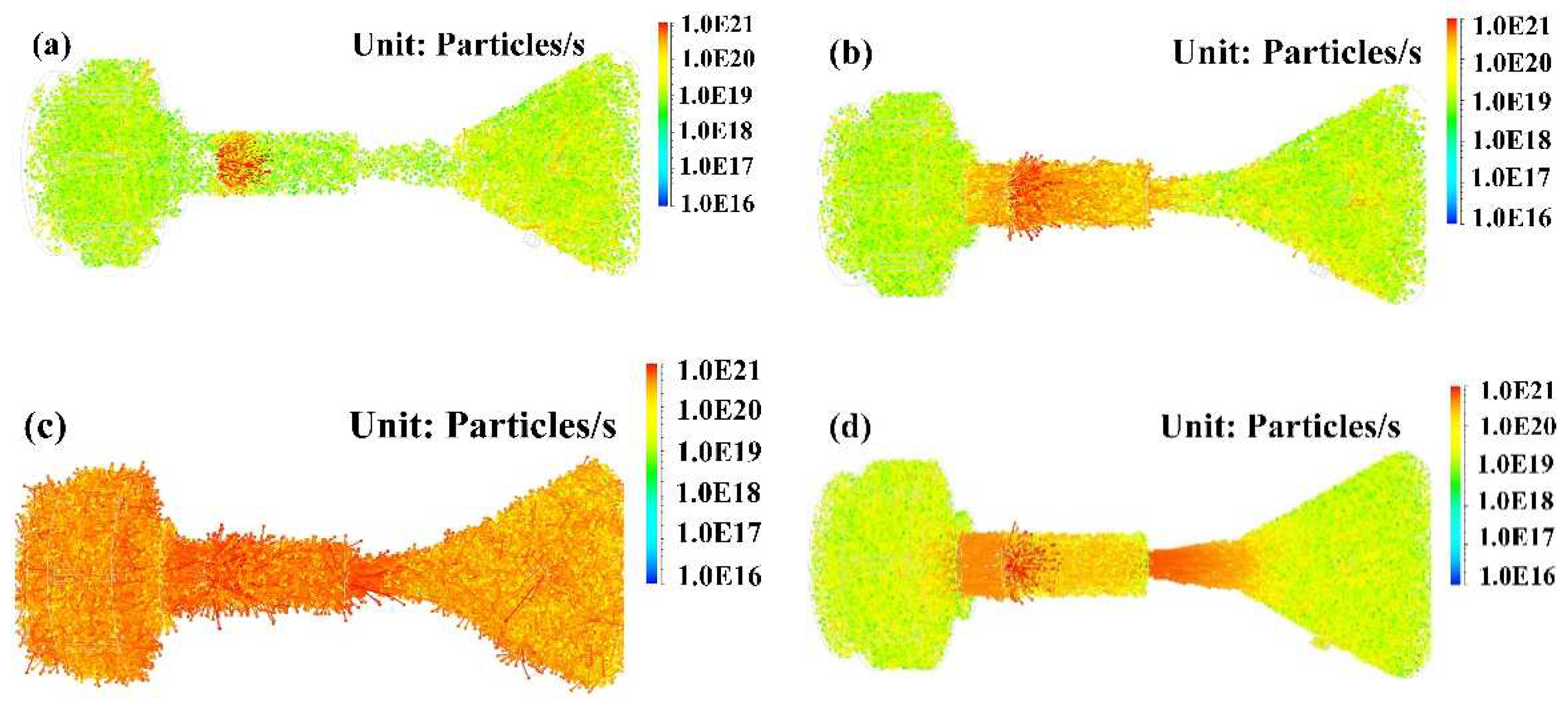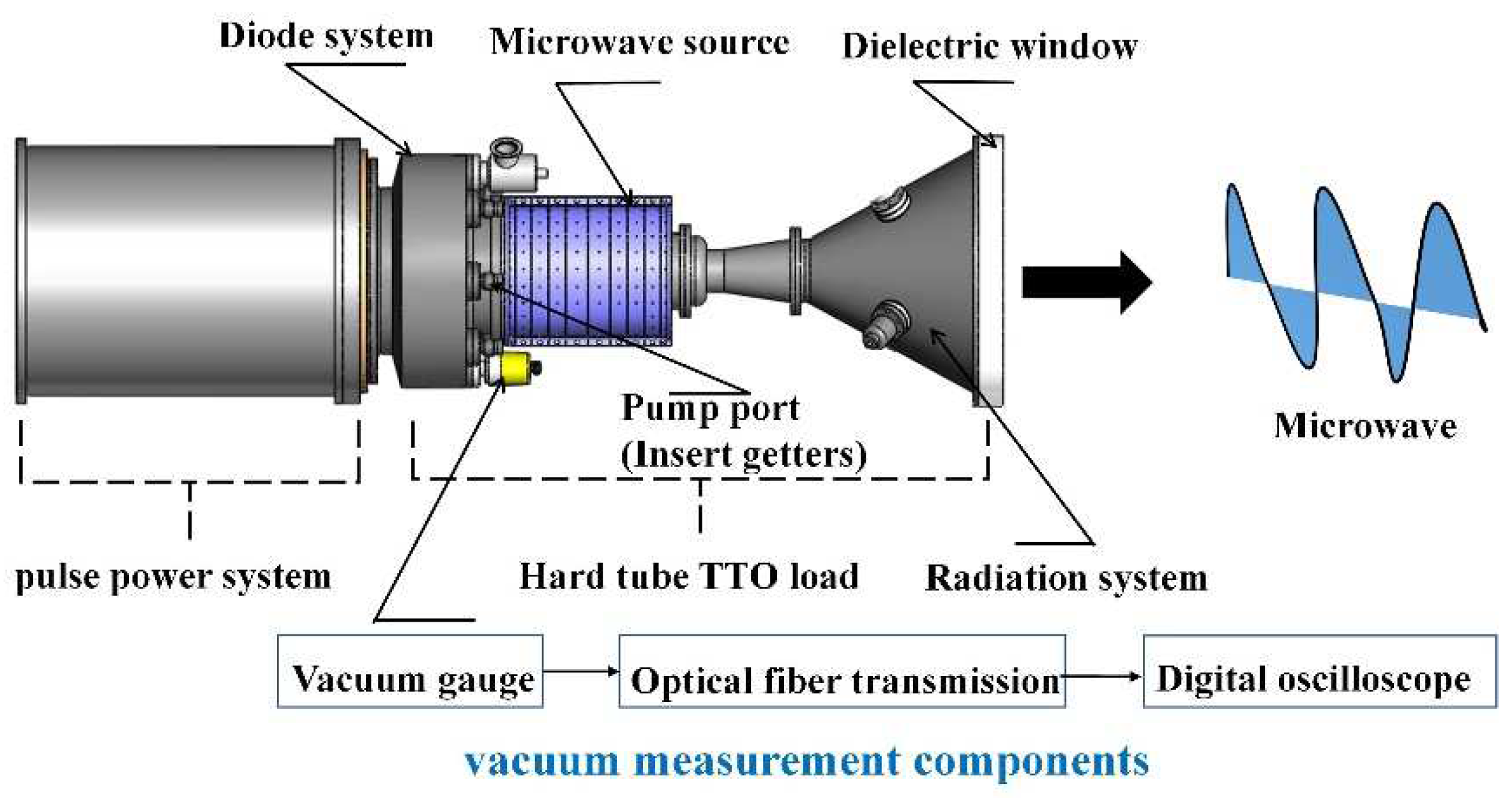A Dynamic Pumping Model for a Vacuum-Sealed Gigawatt Repetitively Operated High-Power Microwave Source
Abstract
:1. Introduction
2. Proposed Dynamic Pumping Model
3. Experiments
3.1. Experimental Setup
3.2. Experimental Results
4. Conclusions
Author Contributions
Funding
Institutional Review Board Statement
Informed Consent Statement
Data Availability Statement
Conflicts of Interest
References
- He, J. Research on a New Transit Time Oscillator; National University of Defense Technology: Changsha, China, 2004. [Google Scholar]
- Barker, R.J.; Schamiloglu, E. High-Power Microwave Sources and Technologies; Wiley-IEEE Press: Hoboken, NJ, USA, 2001. [Google Scholar]
- Ling, J.; He, J.; Zhang, J.; Cao, Y.; Bai, X. Simulation of Traveling Wave Extraction Coaxial Transit Time Oscillator. J. Natl. Univ. Def. Technol. 2013, 35, 120–125. [Google Scholar]
- Adhikary, B.; Shyam, A.; Shukla, R.; Sharma, S.K. Fast Marx Generator for Directly Driving a Virtual Cathode Oscillator. J. Korean Phys. Soc. 2011, 59, 3476–3480. [Google Scholar] [CrossRef]
- Schamiloglu, E. High Power Microwave Sources and Applications. IEEE MTT-S 2004, 2, 1001–1004. [Google Scholar]
- Sedek, E.; Slomski, R. Overview of Microwave Direct Energy Weapons. In Proceedings of the 2015 Signal Processing Symposium (SPSympo), Debe, Poland, 10–12 June 2015; pp. 1–3. [Google Scholar]
- Sannibale, F.; Filippetto, D.; Papadopoulos, C.F.; Staples, J.; Wells, R.; Bailey, B.; Baptiste, K.; Corlett, J.; Cork, C.; De Santis, S.; et al. Advanced photoinjector experiment photogun commissioning results. Phys. Rev. Spec. Top.-Accel. Beams 2012, 15, 103501. [Google Scholar] [CrossRef] [Green Version]
- Walter, J.W.; Lynn, C.F.; Dickens, J.C.; Kristiansen, M. Operation of a sealed-tube-vircator high-power-microwave source. IEEE Trans. Plasma Sci. 2012, 40, 1618–1621. [Google Scholar] [CrossRef]
- Jeon, W.; Lim, J.E.; Moon, M.W.; Jung, K.B.; Park, W.B.; Shin, H.M.; Seo, Y.; Choi, E.H. Output characteristics of the high-power microwave generated from a coaxial vircator with a bar reflector in a drift region. IEEE Trans. Plasma Sci. 2006, 34, 937–944. [Google Scholar] [CrossRef]
- Knoll, M. Materials and Processes of Electron Devices; Springer: Berlin, Germany, 1959. [Google Scholar]
- Rosebury, F. MIT Tube Laboratory Manual; MIT Press: Cambridge, MA, USA, 1951. [Google Scholar]
- Parson, J.M.; Lynn, C.F.; Scott, M.C.; Calico, S.E.; Dickens, J.C.; Neuber, A.A.; Mankowski, J.J. A frequency stable vacuum-sealed tube high-power microwave vircator operated at 500 Hz. IEEE Electron Device Lett. 2015, 36, 508–510. [Google Scholar] [CrossRef]
- Xun, T.; Fan, Y.W.; Yang, H.W.; Zhang, Z.C.; Chen, D.Q.; Zhang, J.D. A vacuum-sealed, gigawatt-class, repetitively pulsed high-power microwave source. J. Appl. Phys. 2017, 121, 234502. [Google Scholar] [CrossRef]
- Kelly, P.M.; Parson, J.M.; Lynn, C.; Taylor, M.; Dickens, J.C.; Neuber, A.; Mankowski, J.; Calico, S.; Scott, M. Performance of St707 getter material in a rep-rated high power microwave sealed-tube vircator under UHV conditions. In Proceedings of the 2014 IEEE International Power Modulator and High Voltage Conference (IPMHVC), Santa Fe, NM, USA, 1–5 June 2014; pp. 213–216. [Google Scholar]
- Mumtaz, S.; Lim, J.S.; Ghimire, B. Enhancing the power of high-power microwaves by using zone plate and investigations for the position of virtual cathode inside the drift tube. J. Plasma Phys. 2018, 25, 103113. [Google Scholar] [CrossRef]
- Xun, T.; Zhao, Y.; Yang, H.; Hu, T.; Zhang, Z.; Cheng, X.B.; Zhang, J.; Zhang, J.; Zhong, H.H. Developments of pulsed electron beam sources for high-power microwave applications. IEEE Access 2020, 8, 101351–101358. [Google Scholar] [CrossRef]
- Xun, T.; Yang, H.; Zhang, J.; Zhang, Z. Effects of vacuum pressures on the performance of a velvet cathode under repetitive high-current pulse discharges. Vacuum 2010, 85, 322–326. [Google Scholar] [CrossRef]
- Zhao, X.; Xun, T.; Liu, L.; Cai, D. Maintenance of high vacuum level in a compact and lightweight sealed hard-tube magnetically insulated line oscillator system. Vacuum 2015, 111, 55–59. [Google Scholar] [CrossRef]
- Li, A.K.; Fan, Y.W.; Qian, B.L.; Li, S.; Yang, H.W. Improvement of vacuum maintenance capability and output pulse limit in a hard-tube MILO with a carbon fiber array cathode. Vacuum 2020, 181, 109723. [Google Scholar] [CrossRef]
- Xun, T.; Zhang, J.; Yang, H.; Zhang, Z. A distributed pumping model for a repetitive operated magnetically insulated transmission line oscillator. J. Appl. Phys. 2013, 113, 164505. [Google Scholar]
- Li, L.; Men, T.; Liu, L. Dynamics of virtual cathode oscillation analyzed by impedance changes in high-power diodes. Int. J. Appl. Phys. 2007, 102, 123309. [Google Scholar] [CrossRef]
- Cuneo, M.E.; Menge, P.R.; Hanson, D.L.; Fowler, W.E.; Bernard, M.A.; Ziska, G.R.; Filuk, A.B.; Pointon, T.D.; Vesey, R.A.; Welch, D.R.; et al. Results of vacuum cleaning techniques on the performance of LiF field-threshold ion sources on extraction applied-B ion diodes at 1-10 TW. IEEE Trans. Plasma Sci. 1997, 25, 229–251. [Google Scholar] [CrossRef]
- Cuneo, M.E. The effect of electrode contamination, cleaning and conditioning on high-energy pulsed-power device performance. IEEE Trans. Dielectr. Electr. Insul. 1999, 6, 469–485. [Google Scholar] [CrossRef]
- Shen, C. Direct Simulation Monte-Carlo (DSMC) Method. In Rarefied Gas Dynamics: Fundamentals, Simulations and Micro Flows; Springer: Berlin/Heidelberg, Germany, 2005; pp. 275–315. [Google Scholar]
- Borgnakke, C.; Larsen, P.S. Statistical collision model for Monte Carlo simulation of polyatomic gas mixture. J. Comput. Phys. 1975, 18, 405–420. [Google Scholar] [CrossRef]
- Alexander, F.J.; Garcia, A.L. The direct simulation Monte Carlo method. Comput. Phys. 1997, 11, 588–593. [Google Scholar] [CrossRef]
- Bird, G.A. Molecular Gas Dynamics and the Direct Simulation of Gas Flows; Clarendon Press: Oxford, UK, 1994. [Google Scholar]
- Sharipov, F. Rarefied Gas Dynamics: Fundamentals for Research and Practice; John Wiley & Sons: Hoboken, NJ, USA, 2015. [Google Scholar]
- Park, W.; Tokioka, H.; Tanaka, M.; Choi, J. DLC coating on a micro-trench by bipolar PBII&D and analysis of plasma behaviour. J. Phys. D Appl. Phys. 2014, 47, 335306. [Google Scholar]
- Maccallini, E.; Siviero, F.; Bonucci, A.; Conte, A.; Srivastava, P.; Paolo, M. Non evaporable getter (NEG) technology: A powerful tool for UHV-XHV systems. In AIP Conference Proceedings; American Institute of Physics: Melville, NY, USA, 2012; Volume 1451, pp. 24–27. [Google Scholar]
- Rocha, E.; Kelly, P.M.; Parson, J.M.; Lynn, C.F.; Dickens, J.C.; Neuber, A.A.; Mankowski, J.J.; Queller, T.; Gleizer, J.; Krasik, Y.E.; et al. Evaluating the performance of a carbon-epoxy capillary cathode and carbon fiber cathode in a sealed-tube vircator under UHV conditions. IEEE Trans. Plasma Sci. 2015, 43, 2670–2675. [Google Scholar] [CrossRef]
- Ozawa, T.; Suzuki, T.; Fujita, K. Investigation of condensation and evaporation effect on CO2 hypersonic rarefied aerodynamic measurements. In AIP Conference Proceedings; AIP Publishing LLC: Melville, NY, USA, 2019; Volume 2132, p. 050004. [Google Scholar]
- Balat-Pichelin, M.; Iacono, J.; Boubert, P. Recombination coefficient of atomic oxygen on ceramic materials in a CO2 plasma flow for the simulation of a Martian entry. Ceram. Int. 2016, 42, 2761–2769. [Google Scholar] [CrossRef]
- Vara, J. Anode Material Testing in a Vacuum Diode. Master’s Thesis, Texas Tech University, Lubbock, Texas, USA, May 2011. [Google Scholar]
- Yoshimura, N. Vacuum Technology: Practice for Scientific Instruments; Springer Science & Business Media: Berlin/Heidelberg, Germany, 2007. [Google Scholar]
- Qiu, A.; Li, Y.; Wang, Z.; Shen, Z.; Zhang, Y.; Zeng, Z.; Zhang, J.; Gai, T. A relativistic electron beam accelerator—Flash II. High Power Laser Part. Beams 1991, 3, 340–348. [Google Scholar]
- Wang, R.; Lv, Y.; Luo, L.; Zhu, W.; Xun, T. On-line vacuum measurement of a high-power microwave source. High Power Laser Part. Beams 2018, 30, 43–47. [Google Scholar]
- Tan, R.R.; Ran, H.; Cheng, G. A B-Dot-based method for short pulse current measurement at kA level. J. Terahertz Sci. Electron. Inf. 2015, 13, 990–994. [Google Scholar]
- Miller, R.B. Mechanism of explosive electron emission for dielectric fiber (velvet) cathodes. J. Appl. Phys. 1998, 84, 3880–3889. [Google Scholar] [CrossRef]
- Xun, T.; Yang, H.W.; Zhang, J.D. A high-vacuum high-electric-field pulsed power interface based on a ceramic insulator. IEEE Trans. Plasma Sci. 2015, 43, 4130–4135. [Google Scholar] [CrossRef]








Publisher’s Note: MDPI stays neutral with regard to jurisdictional claims in published maps and institutional affiliations. |
© 2022 by the authors. Licensee MDPI, Basel, Switzerland. This article is an open access article distributed under the terms and conditions of the Creative Commons Attribution (CC BY) license (https://creativecommons.org/licenses/by/4.0/).
Share and Cite
Tang, S.; Wang, R.; Ling, J.; Zhang, Q.; Chu, X.; Liu, Z.; Xun, T. A Dynamic Pumping Model for a Vacuum-Sealed Gigawatt Repetitively Operated High-Power Microwave Source. Electronics 2022, 11, 3444. https://doi.org/10.3390/electronics11213444
Tang S, Wang R, Ling J, Zhang Q, Chu X, Liu Z, Xun T. A Dynamic Pumping Model for a Vacuum-Sealed Gigawatt Repetitively Operated High-Power Microwave Source. Electronics. 2022; 11(21):3444. https://doi.org/10.3390/electronics11213444
Chicago/Turabian StyleTang, Shunyu, Ripin Wang, Junpu Ling, Qiang Zhang, Xu Chu, Zeyang Liu, and Tao Xun. 2022. "A Dynamic Pumping Model for a Vacuum-Sealed Gigawatt Repetitively Operated High-Power Microwave Source" Electronics 11, no. 21: 3444. https://doi.org/10.3390/electronics11213444




